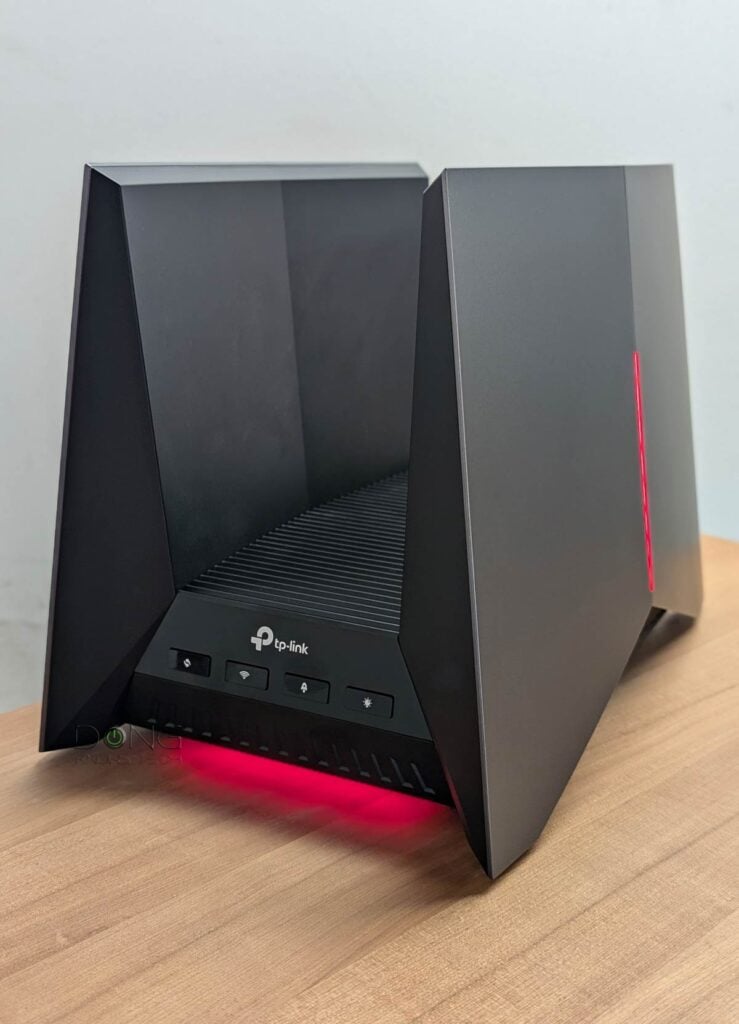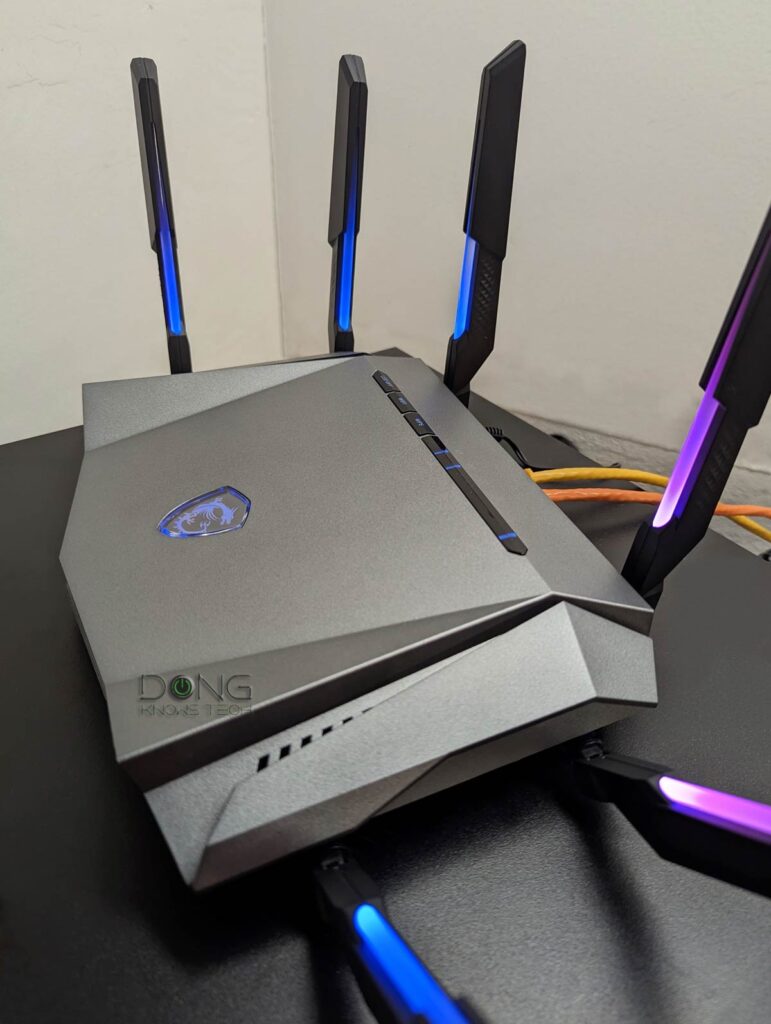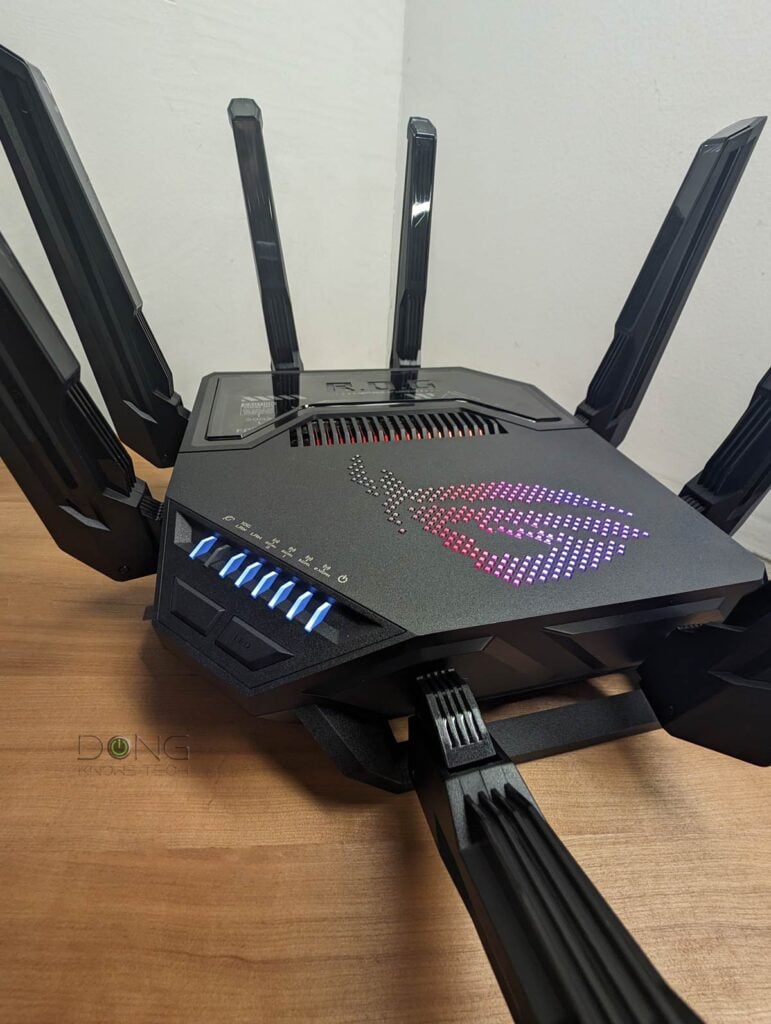This post is a collection of the best five gaming routers and their worthy alternatives out of those I’ve reviewed. There’s no concrete definition of a “gaming router,” but all listed below meet at least two of my qualifying criteria.
Any of these mentioned here will give you an edge in getting connected, plus the much-needed placebo effect. Among other things, you know you’re already well-equipped, possibly even better-geared than the other guy.
Dong’s note: I first published this post on January 29, 2021, and updated it on February 27, 2024, with up-to-date options.
Best gaming routers: The list
All routers on this list are excellent for general use. On top of that, they collectively check all the gaming boxes. The routers below are listed in the recommendation order, with the most recommended on top—the numbers are the ranking.
1. ASUS GT-BE98 Pro: Representing ASUS’s vast collection of gaming routers


ASUS has undoubtedly been the leader in gaming routers. It has the largest collection of all shapes and sizes. The company has routers in three series—RT, ROG, and ROG Strix (or TUF)—with different flavors of gaming-related features and hardware designs.
Asus’s networking hardware
ASUS has a vast collection of Wi-Fi hardware options available as standalone routers and purpose-built Wi-Fi systems—all share the same ASUSWRT firmware—in the following series:
- The RT series: General consumer-grade standalone routers ranging from entry-level, mid-range, and high-end models. Improved variants might carry the “Pro” suffix, such as the RT-AX88U Pro.
- The TUF and ROG series: Gaming-related Wi-Fi routers of different tiers, including the highest-end flagship routers. Improved variants, such as the GT-AX11000 Pro, might carry the “Pro” suffix.
- The ZenWiFi series: This series includes consumer-grade, purpose-built AiMesh-based(*) Wi-Fi systems with a broad range of configurations. Some variants have built-in MOCA or Powerline support.
- The ExpertWiFi series: First announced in early 2024, ExpertWiFi is ASUS’s hardware for networking enthusiasts and office environments. These are AiMesh-enabled business-oriented solutions with more advanced options for network customization and hardware design, available as purpose-built mesh systems, standalone routers, access points (APs), and switches.
The GT-BE98 Pro is the latest flagship router that supports Wi-Fi 7 and delivers non-compromising performance on all accounts. It has everything to represent this large pack.
Still, any ASUS alternatives in the table below will deliver a similar gaming experience.
All of these routers have the standard set of ASUS’s gaming features, including Mobile Game Mode, Open NAT, Gear Accelerator, and VPN Fusion.
2. Archer GE800: TP-Link’s first real gaming router


The Archer GE800 is TP-Link’s latest gaming router and the first real one. Prior to it, previous gaming routers from the vendor, namely the Archer AX11000 and Archer GX90, had little more than a fancy look.
The new Archer GE800 is massive and features full multi-Gigabit ports and Wi-Fi 7. It’s easily the best standalone router TP-Link has ever made to date.
Similar or not-so-similar alternative:
Pros
Top-tier tri-band Wi-Fi 7 specs with full multi-Gigabit to deliver excellent real-world performance
Robust web user interface with an excellent set of network features and Wi-Fi settings, including MLO and gaming-related features
Competitively priced; useful (optional) mobile app; EasyMesh-ready; cool-looking design
Cons
Bulky design with audible internal fan; runs hot; Wi-Fi throughputs could be comparatively a tad better
No AFC; online protection and advanced parental controls require subscriptions
3. RadiX AXE66000: Representing MSI’s return to home networking


The Wi-Fi 6E RaiX AXE6600 and its Wi-Fi 6 cousin RadiX AX6600 are the first Wi-Fi routers from MSI in many years. And they are both marked as gaming routers.
On the inside, their gaming features are all QoS-based. So, the two are similar to TP-Link’s Archer GX90 below, as both don’t have the most comprehensive set of gaming-related features.
But you’ll be able to play games with them just fine. And the RadiX AXE6600 tops that off with an incredible set of Mystic Light. In the near future, the company will have an all-new and exciting Wi-Fi 7 RadiX BE22000 Turbo on the horizon.
Similar alternative:
Pros
Top Wi-Fi 6E specs; cool Mystic Light; Reliable Wi-Fi performance
Lightweight yet robust web user interface; helpful mobile app
Supports all standard home network settings, deep Wi-Fi customization
Nice design, low power consumption
Cons
Only one 2.5Gbps port; mediocre 5GHz specs
Thin on gaming and network protection features; no Dynamic DNS, Link Aggregation, or Dual-WAN
Mystic Light requires a PC app; Network storage requires SMBv1 with lackluster performance
4. NETGEAR XR1000: Representing NETGEAR’s DumaOS-based routers


The XR1000 is a Wi-Fi 6 upgrade to the Wi-Fi 5 version XR500. It’s the second gaming router based on game-centric DumaOS firmware and has fantastic gaming features, including an improved Geo-Filter with polygon mode and Ping heatmap.
Similar alternative: Any DumaOS-based router, such as:
Pros
Sophisticated game-centric firmware
Fast Wi-Fi speeds and reliable performance
Robust web UI, beautiful hardware design
Useful mobile app, wall-mount-ready
Cons
Expensive but underpowered – items of the web interface can take a long time to fully load
Limited Wi-Fi settings, sluggish user interface
Mobile app can’t manage any gaming features
No multi-gig port, Dual-WAN, or Link Aggregation
Online protection and VPN require subscriptions
Buggy — firmware needs some serious updates; no mesh option
5. Netduma R3: A pure DumaOS gaming router


The R3 is similar to the NETGEAR above since it runs on DumaOS. However, it’s more of a thoroughbred version since Netduma, the maker of the OS, also makes the hardware. That said, the R3 is designed from the ground up for gaming.
Unfortunately, gaming is not the end-all and be-all of a router. And on that front, the R3 falls short. The fact that, while released in late 2023, it’s merely a mid-tier Wi-Fi 6 router without any Multi-Gig port alone can be a deal breaker for many.
Pros
DumaOS 4.0 with a responsive web user interface and sleek gaming features effective for a particular class of games
Practical design with RGB programmable lighting
Useful mobile app, wall-mount-ready
Cons
Dated hardware specs, no 6GHz or Multi-Gig port, the USB port is a placeholder
Limited Wi-Fi settings and general features
At times, Beta-like buggy firmware
Tips on gaming and Wi-Fi
Generally, get your home wired for the best online experience, including online gaming or whenever you want to ensure the connection is reliable and has the lowest latency.
After that, connect your gaming rig to your network via a cable. No matter how fast, Wi-Fi is always less ideal and will put a few extra milliseconds, or even a lot, on your broadband’s latency.
Reliability and low latency are more critical than fast speeds in gaming or any real-time communication applications. So it’s more a question of wired vs. Wi-Fi than Wi-Fi 5 vs. Wi-Fi 6 vs. Wi-Fi 7.
But we can’t always use wires. That said, the rule in Wi-Fi for gaming is to avoid multiple hops.
Specifically, here is the order of best practices when connecting your gaming device to the network via Wi-Fi:
- Use a single broadcaster—just one Wi-Fi router or access point.
- If you must use multiple broadcasters (like a mesh system), then:
- Use a network cable to link them together (wired backhaul).
- If you must use a wireless mesh, then:
- Connect the game console directly to your home’s first broadcaster—the primary router. Or
- Connect the gaming device to the first mesh satellite node using a network cable. Also, in this case, it’s best to use mesh hardware with an additional 5GHz band unless you have Wi-Fi 7.
- Avoid the daisy-chain mesh setup.
- Avoid using extenders. If you must use one, make sure it’s a tri-band.
Again, the idea is that the Wi-Fi signal should not have to hop wirelessly any additional time before it gets to your device—you’ll get significantly worse latency after each additional hop.
The final thoughts
Generally, you can play games with any router. Most routers with a good QoS feature can be manually tuned to support a particular game well. But gaming-oriented routers make things easier since most can automatically change their setting when you pick a game.
Still, at the end of the day, it’s your skill and the quality of your broadband connection that matter; there’s only so much a router can do.
